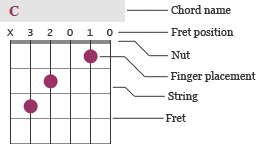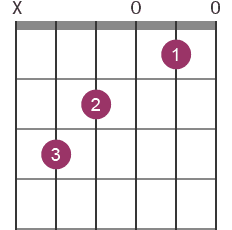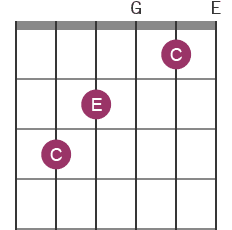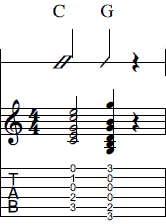How to read chord diagrams
The chord chart or diagram is a schematic presentation of a chord, in this case for the guitar. Chord charts are the most advantageous way to learn how chords are played. If you are uncertain how to interpret charts, this guide will teach you that.
A chord diagram is packed with information:
- The name of the chord.
- Fret positions (numbers explains the position of the chord on the fretboard).
- Finger placements (on this site, violet dots mark where you place your fingers).
- Strings (six horizontal lines represent the guitar strings; the thickest strings are to the left).
- Frets (vertical lines are representing the frets on the guitar).
This diagram explains further how to read a chord chart.

There are other ways to describe a chord on the guitar schematically. A common method is to mark out the fret box by a number on the side (the numbers above the fret position give that information on the diagrams on this site. Somewhat common is also to mark out which fingers to use. This can be beneficial, but in most cases the correct fingerings are the most logical and on the other hand, which is important, is fingerings dependent on the situation. Are you still convinced that you prefer diagrams with fingerings, this chord chart ebook include fingerings in many cases.
Charts including fingers and notes
Some of the chord charts on this website is presented with fingers or notes:


The fingers should be understanded as 1 = index finger, 2 = middle finger, 3) ring finger and 4 = little finger. Sometimes is "T" used, when the thumb is indicated (which is uncommon though, but can be the best way to in some situations). As already mention, the X and 0 stands for muted and open string.
The notes are written out on the positions. The open strings that should be played has also the note of the open string written out. Strings that shouldn't be played has no letters.
Look, it's the same chord!
Every picture below shows a G chord. The last diagram is that Guitar-chord.org use and that delivers the information you need in a cut down design. The simplification makes it fast to read and easy to understand.

You may miss instructions about which fingers to use. The thing is, though, that the same chord sometimes can be played with different fingerings. As a rule of thumb use what comes naturally for you and what doesn't involve unnecessary stretches.
You can read more about this subject in the article How to place the fingers.
Different ways a chord can be notated
In sheet music, chord can be presented in different ways. In the image below, three forms of presentation are shown together. What they all tell is that a C major chord is played as a half note followed by a G chord played as quarter note.
The upper part is a simplified way of showing chords and rhythms with letters and symbols. The middle part is standard notation and the lower part is tabulation (tab).

Common questions
What does the numbers over, under or on the side of the chart mean?
Numbers above or below the chord chart can normally indicate two things: the fret numbers or the fingerings. Roman numbers besides the chord chart indicate a fret and is indicated when the chord chart displays position higher up the fretboard.
Why are the charts vertical and not horizontal?
Not always, but most often the chart is displayed vertical, which may be counter-intuitive since when we play, we see the fretboard horizontally. It's hard to say why this has become a standard, but in many occasions, it may be easier to fit chord charts in book layouts etc. using this approach.
Why are the charts including four or five frets?
As a standard, four or five frets are included in charts. It's true that some chords exceed this limit, but since a big majority can be displayed on a maximum of five frets it would take unnecessary space to increase the charts beyond five frets.
Why are the symbols a mix of circles, square and diamonds?
The charts on Gutar-chord.org has only circles to indicate finger positions and use color codes in cases where distinguishes are needed. In some presentations (especially in black and white layouts), squares and diamonds are included. These are mostly used to distinguish the root in chords from the other notes.
Read also about How to read short notated chords | chord and standard notation.